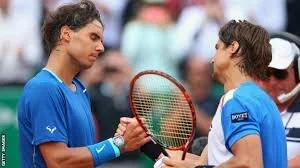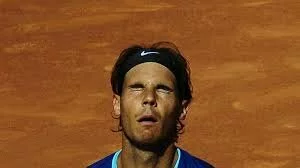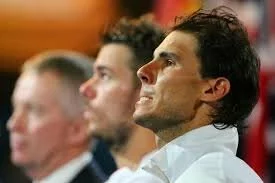Imagine if you could just turn the volume down on your Tennis Hate. Imagine if you could reach up to your forehead -- or maybe have your doubles partner do it -- and turn a knob, the one that's over your third eye, to silence that voice that's hissing like a tea kettle, "That shot sucked, you've got the worst forehand in the league, you are never going to succeed at this sport, go take up basketweaving, it suits you better."
My Tennis Hate is at 11 dB. One louder. Photo, artistry: Me.
Worthy Pro Jeff Greenwald wants us Tennis Haters to do just that when we're playing, to think about dials instead of how sucky and freaked out we are that we're blowing easy volleys. Rather than standing at the service line, thinking of how I'm serving, 0-5, his "mental game changer" method would have me think of a different set of numbers, ones that indicate the level I'm playing at when it comes to intensity, looseness and focus.
"You don't try to relax," he told me in a recent telephone interview from his base in Marin County, California. "That doesn't work."
Haters, don't we know this to be true? The more I tell myself to relax, the more I tighten up. I have whiffed plenty of shots, especially second serve returns, immediately after exhorting myself to focus on this next shot, get this next shot, nail it. My tennis game is like a 16-year-old. The more I command it to be a certain way, the more it rebels and does exactly the opposite.
Imagine if you could reach up to your forehead -- or maybe have your doubls partner do it -- and turn a knob to silence that voice that's hissing like a tea kettle, "You Hate Tennis."
Greenwald, a former touring pro, a national and international senior circuit world number one, sports psychology consultant and licensed therapist, has a two-hour downloadable Tennis Hate reduction method called, "Play Out of Your Mind: The Mental Game Changer." It combines some of the stress reduction strategies he outlined ten years ago in his audio course, Fearless Tennis, with his recent work with performance "dials."
Jeff Greenwald: Feet Intensity, 8; Looseness, 4: Focusing cue, stay down. Photo: Jeff Greenwald.The work begins, Greenwald said, with becoming aware of what's going on in your body and your head on the court and accepting it. Yes, Haters, embrace the Hate. It's what I've been encouraging you to do all along!
"The first thing is accepting the reality of the moment, and that offers you options and perspective," he said. Acceptance begins with awareness. Greenwald advises scanning your body for tension, and just noticing it. That's all. Hello, my neck feels like rebar and my service arm feels like a 2x4.
I remember working with Greenwald on this at the US Tennis Congress last fall. He had me and several other participants do this mental scan before serving or returning serve. "Just observe how you're feeling, where your muscles are tight, don't try to relax them," he instructed. "Now, think about your feet. Notice your toes, wiggle them around in your shoes." I fluttered my toes, noticing how sweaty they were. Yuck.
Uh oh, a judgmental thought. Okay, Amy, so they're sweaty. Duly noted, let's move on....
"Now bring your attention to the ball," he told us. He was giving us a pathway, a trail of breadcrumbs, out of our heads, into our bodies and back onto the court.
With Play Out of Your Mind, he offers additional tools to get Tennis Haters into their optimum performance state while in the middle of the on court drama. After becoming aware of the tension I'm holding in my body, and accepting it, I can now take a course of action to dial up....or down....a deeper level of Focus, Looseness and Intensity.
"Say that you are at an 8," Greenwald said about Looseness. "You're really nervous, really tight." (Man, I'm this way even in practice, let alone matches.) "If you can go from 8 to 6, you have good chance to win the match."
He offers a PDF file with his audio course with tips on how to find and drill with this concept of dials and numbers.
Hit down the middle with low tension (1) and move up scale to (10), spending 30 seconds or 1 to 2 good rallies to connect level of tension with ball striking. Stop after you reach (6) on the dial to see/assess and observe tension level. Discuss with partner or coach.
During the Tennis Congress, Jeff had us start with a level of 8. Some in the group started really nailing the ball well, interpreting Greenwald's instructions as Intensity rather than Looseness or tension. "I want you to think of how your body feels when you're really tense and scared on court, really nervous."
Crank 'em up. Or down, depending. From Jeff Greenwald's Play Out of Your Mind's Quick Start Guide.
Oh, that dial! My buddies and I started recalibrating. I tensed my arm up as hard as I could, pulled my shoulders up toward my ears, where they usually reside, clenched my jaw. You know, my natural on court state. I couldn't clear the net. My fellow Congressmembers were getting the same, pushy results.
Greenwald congratulated us on how tight we were. "Those are great 8's," he said. Now he had us dial it down to a 2 or 3. "What does that feel like? What's your 3?"
It took a few passes before I could hone in on the feeling. I wanted to go all spaghetti, but you can't hit a ball that way. There has to be some flexing of the muscles of the shoulder, arm and wrist as it pulls the racquet into the ball. But there it was, a feeling of release, of flow, an uncharacteristic smoothness and fluidity to my forehand that I savored in the experiencing of it. I couldn't wait to hit the ball again. It was pleasurable. It was clean and unobstructed by mental chatter or extra, unnecessary clenching. My balls sailed easy and deep into the opposite court.
Wow.
But my Tennis Hate immediately seizes on a conundrum: How do you play Loose without playing Careless? How do you play with Intensity while staying Loose? I'm a Type A overdrive kind of player. I've told myself, in the midst of a match, when I'm losing and wanting to cry or smash my racquet or just check out, let them win, who cares, thinking that that will take off the pressure. Thinking that that's "letting go" and being "loose."
No, that's playing LOSE.
"You're hitting the heart of the challenge for many," Greenwald told me. "You're thinking that the solution is by not caring. You need to care a little bit about winning and losing…but not so much."
Greenwald says the performance states of careless, carefee and careful are on a continuum. "You don't want to play careful." That'd be playing at a (10) on your Looseness dial. "You don't want to play careless, reckless." That'd be, perhaps, a 1 on the Intensity dial. "You want to find a way to be more carefree, carefree about the results [of a match or a point], which we only have partial control over, anyhow."
He said working with his dials of Intensity, Focus and Looseness, identifying what my optmium settings are, and learning to conceptualize getting to those levels while in the thick of things in a match, will help me inch further along the path toward...well, if not Rafa Nadal-like mental toughness, then improvement. One less expletive rant after my forehand down the line sails long...so long, it's over the chain link fence and into the neighboring softball field at the Prospect Park Parade Grounds.
"The best in the game, they want to win badly," Greenwald said of the pros. "Rafa wants the ninth French Open title, they want it as bad as anybody else, or more." But rather than focus on a result that is not in their control, Greenwald said the pros have learned how to shift their attention away from results and onto their optimum performance state. Their own little forehead dials.
Nobody gives us a user's manual of our mind."
"Rafa takes a freezing shower to get out of his head," Greenwald said. "[The pros] are like a finely-tuned instrument. Their anxiety is not so much about losing the match as it is performing less than they can and being in a state that they know won't contribute to best tennis. It's the difference between wanting a particular state or winning or losing that match."
His hope for Play Out of Your Mind is to help Tennis Haters like me find that performance state more often.
"Nobody gives us a user's manual of our mind," he said. "I have made a great effort to take what we all experience at every level and be as human and practical in remembering how the brain works [as possible], to give people tools where they can adjust what's happening in the moment in an effective way. The zone happens two times a year, or whatever. Mostly, what we're trying to do is have our worst day be better and our best day happen more often. I think these dials speak to the experience we all have and can help."
 Amy Eddings Posted on
Amy Eddings Posted on  Monday, August 25, 2014 at 6:46PM
Monday, August 25, 2014 at 6:46PM
 AAndrea Petkovic,
AAndrea Petkovic,  Ons Jabeur,
Ons Jabeur,  US Open 2014 | in
US Open 2014 | in  Mental Tennis,
Mental Tennis,  Mental Toughness,
Mental Toughness,  US Open
US Open




